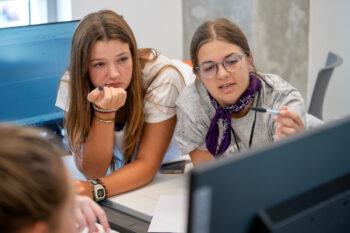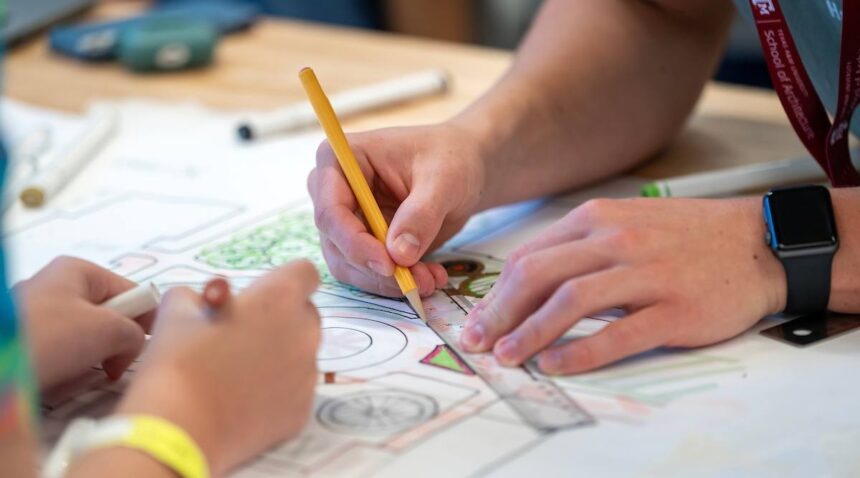Camp ARCH Prepares High School Students To Design And Build A Better World

With the stroke of a pen or the click of a mouse, a bare parking lot becomes a garden. Across campus, a vacant piece of land becomes a gallery, and a nearby bus stop becomes a functional work of art, as top-performing high school students imagine what tomorrow’s Texas A&M could look like.
This week, the Texas A&M University School of Architecture is giving 80 prospective Aggies a preview of the college experience with Camp ARCH, an annual summer program for highly recruited students interested in architecture, construction science, landscape architecture and urban planning. This year’s campers have come from all across Texas and even as far as Dubai to receive hands-on instruction from A&M faculty and students in the state-of-the-art Instructional Laboratory and Innovative Learning Building.

Throughout the week, campers explore the sprawling A&M campus, live in a dorm, and work on a variety of projects aimed at improving the built environment.
“I think it gives us a taste of what we’ll be doing in the future, and you really get to feed off of everyone else’s creativity,” said Aly Gregorek, a two-time Camp ARCH participant from Sugarland, Texas.
Gregorek is part of this year’s landscape architecture and urban planning cohort, under the instruction of Assistant Professor Sungmin Lee. During the week, the campers have been drafting detailed proposals to convert four underutilized areas of campus into beautiful, functional green spaces.
“We went on site and took pictures, and it was really cool to say ‘that’s where we’re going to have a bench, or that’s where we’re going to have a garden,’” Gregorek said.
Soon, she and her teammates were hard at work re-imagining Lot 19 between Hart and Nagle halls as a space for on-campus residents to relax and spend time with friends, complete with a “Gig ‘em”-shaped flower bed and a spot to roast s’mores.
While the plans are theoretical, the knowledge and skills involved are very real. Lee said thinking about the design and function of real-world spaces helps give the students a better picture of the kinds of projects they’ll be working on throughout college and beyond.
“It’s so worthwhile and exciting to work with these talented high schoolers,” Lee said. “With this project, they’re able to imagine what they can do to make more vibrant areas for college students.”

Meanwhile, students in the two architecture cohorts have been designing a variety of practical structures for sites near the future School of Performance, Visualization and Fine Arts (PVFA) building, including a dynamic space for showcasing artwork.
“The interim dean of PVFA, Tim McLaughlin, asked if we would like to be involved in designing an art walk for the new building,” said Associate Dean for Academic Affairs Shelley Holliday. “He’s looking forward to seeing what our campers come up with.”
At the same time, students in the construction science cohort are learning how projects like these are brought to fruition, drafting detailed estimates of all the associated costs. They’ve also made visits to several active construction sites across Bryan-College Station and participated in a series of crucial safety demonstrations under the supervision of Instructional Professor and long-time Camp ARCH instructor Anne McGowan — better known to her students as “Safety Anne.”
“We talk about harnesses, fall safety, equipment safety — many of the actual components we teach within the construction science curriculum for college students,” McGowan said. “We give them the information and then have an activity where they can apply it.”
Each one of McGowan’s campers will go home with an OSHA 10-hour certification, bringing them one step closer to a career in the field.
Still, it’s not all about work. Each day’s schedule includes time for the campers to come together and share meals, participate in fun activities, and get a feel for what a college student’s life is like between classes. Earlier this week, they had a chance to explore the expansive green spaces of Aggie Park and even go swimming at the Student Recreation Center.

Kyra Simpson, a returning camper who hopes to attend A&M after graduation, said it feels good to know her way around the campus, and to know that college isn’t all just lectures and assignments.
“It really has shown me that even going into architecture school, you’re still able to have a life and do other activities,” Simpson said. “Walking on campus, saying ‘Howdy’ to everybody, getting the feel of how everybody acts, it gets us prepared for what things will be like.”
Learning Together
As Camp ARCH Director Karina Badillo explains, much of the program’s success is thanks to its counselors — current School of Architecture students who volunteer to spend the week with the campers and assist them with their projects.
For Simpson and Gregorek, having a group of older, more experienced students to learn from has made the experience all the more enriching.
“Each counselor has a different perspective on the tools we’re using,” Simpson said, “so when you have a question or you need help on something, each counselor has different techniques or secrets to make it easier for you.”
“It’s good to know that our counselors have been where we were,” Gregorek said. “And it’s good for us to know that eventually we’ll be able to do what they can do.”

For the counselors, many of whom attended Camp ARCH before they came to A&M, the week is often just as educational.
“It’s pretty awesome,” said Lilly Rosenbusch, an environmental design sophomore. “I’m there to help guide them, but they’re also helping me further my own understanding. I’m pushing my knowledge of different softwares, and I’m learning all of their different stories, where they’re from, and what their interests are. It makes me happy to be part of a group like that.”
Even for faculty members, Camp ARCH can be a great opportunity to meet a new generation of students and see how they learn: “As a professor, you’ve got to change with the culture and change with the generations,” McGowan said.
James Michael Tate, an assistant professor in the Department of Architecture and instructor for one of this year’s cohorts, said it’s also heartening to see students who are so eager to apply their talents for good.
Ultimately, he said, it gives him hope for the future of the profession and the world at large.
“They want to know how to they can use their creative abilities to solve real-world problems, whether those are social, economic or environmental,” Tate said. “I think they’re drawn to architecture because they see that link between creative responses and those really big challenges we face.”






Media contact: Luke Henkhaus, henkhaus@tamu.edu





